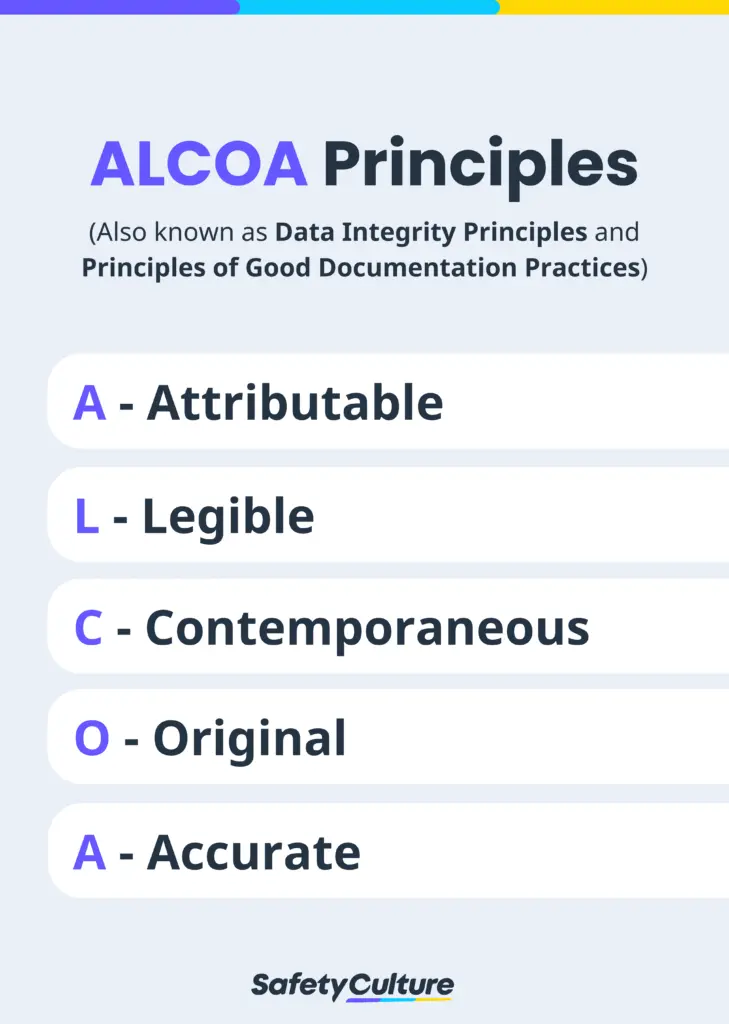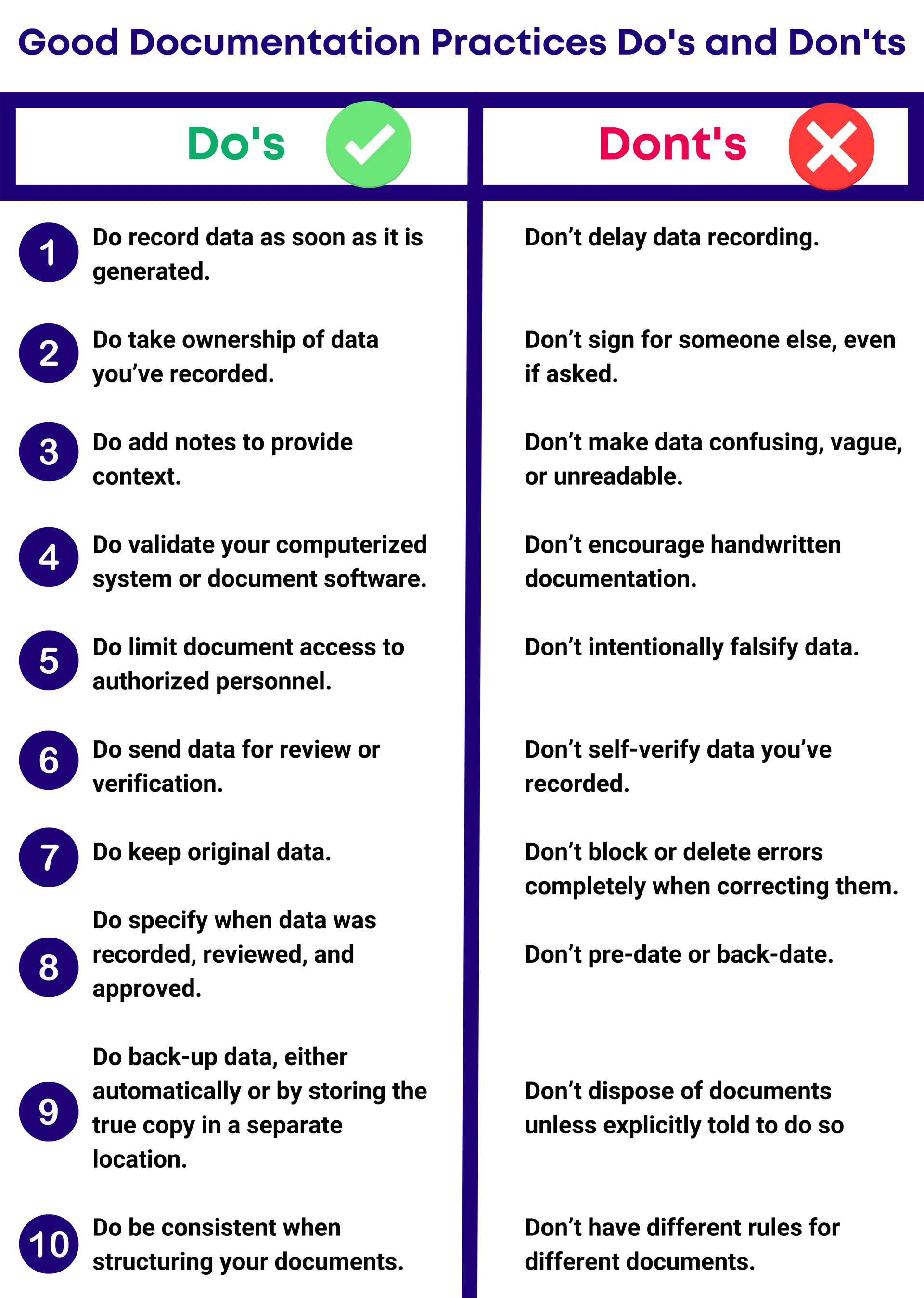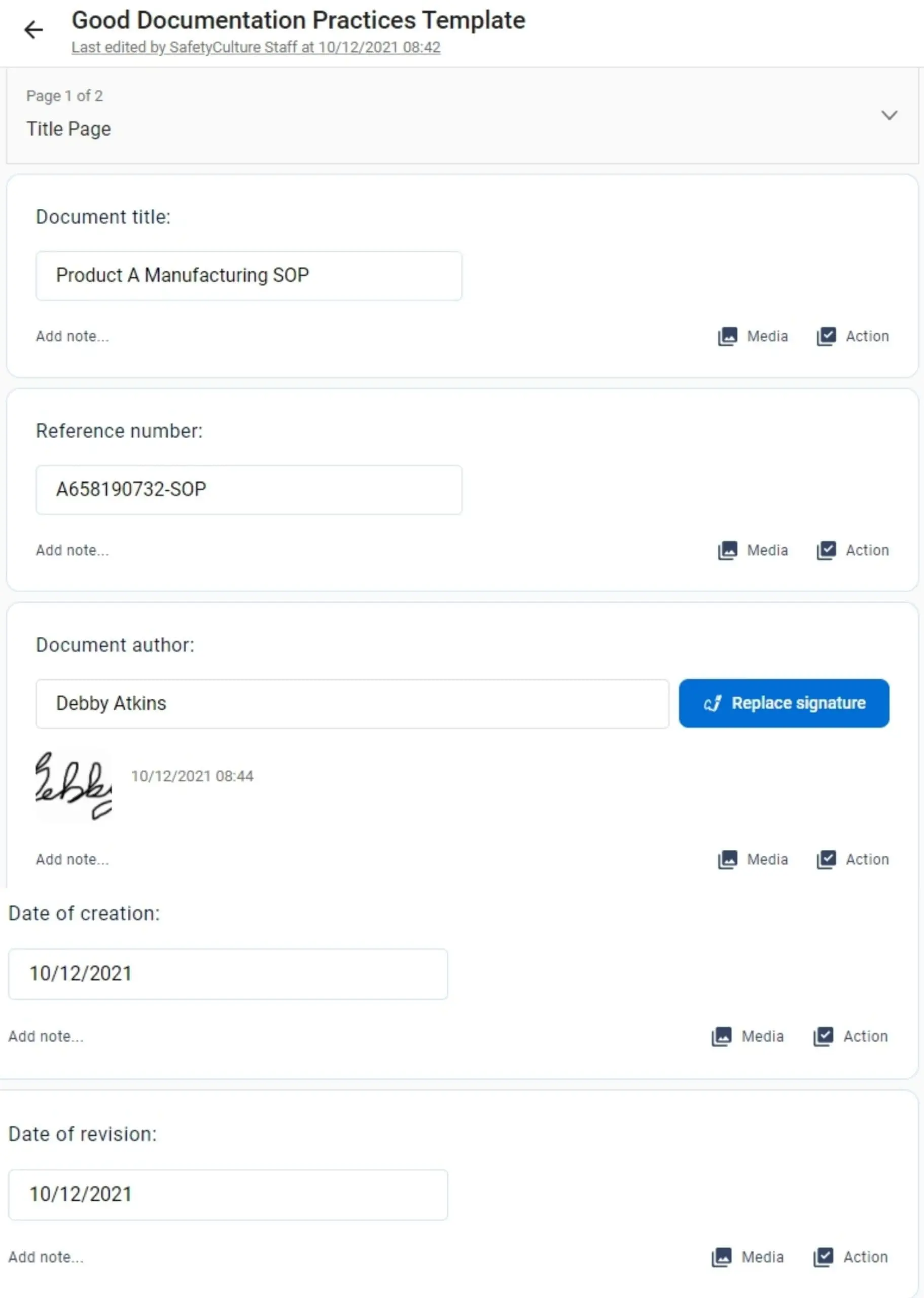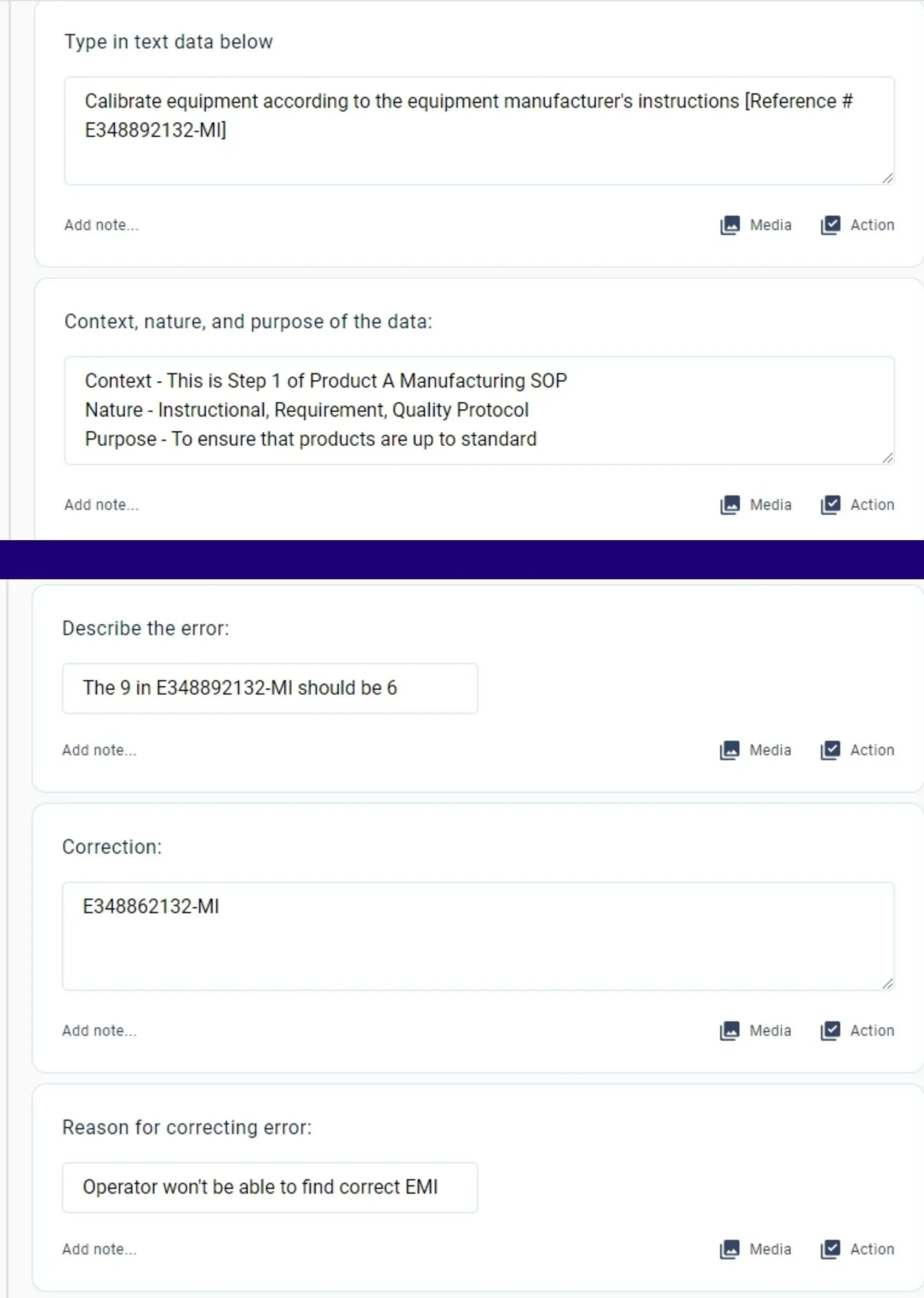What is Good Documentation Practices?
Good documentation practices is a set of best practices for documentation and recordkeeping. It aims to preserve the data integrity of important documents and records and can also serve as guidelines for how to record information and store data appropriately.
Even outside of the pharmaceutical and manufacturing industries, information stored in documents and records, as well as maintaining proper records lifecycle practices, is critical to the functioning of your business. Keeping the following information in order will help you manage your business more efficiently:
- Legal documents – business records, audit statements, and company policies
- Customer information – contact numbers, email addresses, and transaction history
- Procedural documents – standard operating procedures (SOPs), work instructions, and training documents
- Evidence of compliance – the record of audits to confirm that SOPs have been followed and that business processes are compliant with regulations and standards
- Testing or analysis records – for when the quality of a product is checked or assured, when verifying the effectiveness of a product, or capturing data that is critical to the safety and quality of the product
Why You Should Care About Good Documentation Practices
The purpose of good documentation practices is to ensure that businesses and organizations have good data or data that is Attributable, Legible, Contemporaneous, Original, and Accurate (ALCOA).
Data is incredibly powerful and good data allows you to:
- Conduct strategic and high-impact performance improvements;
- Optimize resource allocation and developmental planning; and
- Streamline and maintain a good records management system; and
- Reduce the risk of being declared non-compliant by regulatory agencies.
But how do you get these benefits? Follow the ALCOA principles that make up data integrity and are the cornerstone of good documentation practices. Each principle is discussed in detail below.
ALCOA Principles of Good Documentation Practices
Each letter in the ALCOA acronym corresponds to a characteristic of good data. These characteristics are the principles of good documentation practices.

A – Attributable
What is it: Attributable means that you know where the data came from (who recorded it).
How to apply the principle:
- Each document must have an author. It should be easy to trace information to its source, though ideally the author or the person who recorded the data should be immediately identifiable or named in the document. If needed, permission to edit the document must also be specified according to the level of access.
- Each document must have its author’s signature. This is to verify that the person identified as the author in the document is actually the one who recorded the data.
- There should be no shared passwords or shared data system log-ins. This is to make data entry tracking easier. Similarly, no one should be allowed to sign for someone else. The person who recorded the data must be the one to sign.
L – Legible
What is it: Legible means that data is easily readable and understandable.
How to apply the principle:
- Avoid handwritten documentation. As much as possible, data should be recorded in an electronic document or through the use of a computerized system.
- Information should never be vague or ambiguous. Provide explanations for complex information when possible. Always state the context, nature, and purpose of the data.
- Information should flow logically and be organized in such a way that it is easy to make sense of the data or mentally process it.
C – Contemporaneous
What is it: Contemporaneous means that data is current (applicable at the time of its access) and recorded in real-time (no delay between data generation and data recording).
How to apply this principle:
- Documents should always be kept up-to-date (i.e., reflect the latest version and contain the most recent data and information).
- Documents should have the following dates:
Per Document Data within Each Document Date of creation Date of recording Date of revision Date of correction Effective by Date of review - All dates must be accurate. No pre-dating (documented date is before actual date) or post-dating (documented date is after actual date).
- All signatures must be dated and/or time-stamped.
O – Original
What is it: Original means that data, once recorded, cannot be edited, altered, or erased.
How to apply the principle:
- Though data cannot be edited, any errors in the data can be corrected, provided that the person who recorded the data is the one correcting the error. Corrections can only be done when all of the document’s stakeholders have been informed and the Quality Assurance (QA) Lead has given the correction a go-signal.
- When correcting an error, do not block or erase the error. If the document is handwritten, cross out the error so that it’s still legible. If data was recorded electronically, add a comment stating the error in the data and its corrected form.
- Each correction must be signed and dated by the one who performed the correction (which should also be the person who recorded the data containing the error).
- Access to data should be limited to authorized persons.
A – Accurate
What is it: Accurate means that data can be relied upon to be true, valid, and correct.
How to apply the principle:
- There should be a documented reason for each corrected error. It should specify the exact error, why it had to be corrected, and why the correction made is suitable.
- All data should be reviewed, checked, or validated by someone other than the person who recorded the data and who has the right knowledge and skills to do so.
- Each review, check, or validation of data should be signed and dated by the reviewer.
- Any issues with the validity or truthfulness of data must be investigated further.
- Establish strict protocols, data security measures, and other types of precautions against the intentional falsification of data by either internal or external agents.
In addition, following these practices make it easy for people involved to collaborate, and for the organization itself to ensure data accuracy.
Good Documentation Practices Examples
Two types of good documentation practices examples will be discussed. The first set of good documentation practices examples illustrates their importance and why you should follow them. The second set of examples shows what following good documentation practices looks like in action and will help you gain a clearer understanding of ALCOA principles.
Good Documentation Practices Examples 1
| Scenario: A regulatory authority has some follow-up questions for a business that recently submitted evidence of its compliance with a regulation. |
| Type of information: Evidence of compliance |
| Principle: Attributable |
| Followed: Since the business immediately knows who recorded the compliance data, they are able to ask that person for more information and even have them answer the follow-up questions of the regulatory authority directly. The regulatory authority is able to confirm that the business is 100% compliant with the regulation. |
| Not Followed: Since the records submitted as evidence of compliance don’t identify the person responsible for creating them, the business is having difficulty finding more information on their compliance data. They are unable to answer the regulatory authority’s follow-up questions and are in danger of being deemed as non-compliant by the regulatory authority. |
| Scenario: An employee is performing a critical task and needs to refer to the SOP for that task. |
| Type of information: Procedural documents |
| Principle: Legible |
| Followed: The employee is able to follow the SOP step-by-step since it was recorded electronically and even includes pictures and annotations to guide the employee. The employee performs the task correctly and the output of the task meets the client’s specifications. |
| Not Followed: Since the SOP is handwritten and the author’s handwriting is difficult to read, the employee merely guesses what some steps in the SOP are. As a result, the employee performs the task incorrectly and the output of the task is defective. |
| Scenario: An employee has to contact a customer to inform them that the specific item they wanted to purchase before is now in stock. |
| Type of information: Customer information |
| Principle: Contemporaneous |
| Followed: The contact number listed in the system is the customer’s actual contact number. As soon as the employee texts that number to inform the customer that their desired item is in stock, the customer immediately replies and places an order. |
| Not Followed: The contact number available to the employee is not the current contact number used by the customer. The employee doesn’t know this and keeps calling the old contact number. A significant amount of their time is spent on this. |
Good Documentation Practices Examples 2
Good Documentation Practices Do’s and Don’ts

Good Documentation Practices Implementation
If you’re ready to implement good documentation practices across your business but need extra guidance, refer to the information below.
Before you begin implementing good documentation practices:
- Do your existing documents need to follow good documentation practices?
The answer ultimately depends on you. Do you have the time and enough employees to help you go through existing documents? Note that, for existing paper documents, it will be much harder and will take longer to apply good documentation practices to each one. - If you’ve decided that your existing documents need to follow good documentation practices:
Organize, digitize (if existing documents are paper), and apply the missing good documentation practices to the existing documents.
If you’ve decided that your existing documents don’t need to follow good documentation practices or if you’ve already done the required steps to apply good documentation practices to existing documents, then you can begin the implementation of the following:
- Inform – Hold an intensive training session that emphasizes the importance of good documentation practices and the real-life consequences of not following them (use example scenarios provided earlier). Retrain employees at least every 3 months.
- Enforce – Establish safeguards against non-compliance (e.g., by making certain items mandatory). Assign enforcement responsibility to a Quality Assurance (QA) team lead or create a QA team specifically for enforcing good documentation practices.
- Sustain – Make good documentation practices part of employees’ day-to-day routine. All business procedures involving documentation should follow the set best practices. Regularly check (at least every 6 months) if people across your business are following good documentation practices and if the created documents reflect that.
Follow Good Documentation Practices with SafetyCulture
SafetyCulture (formerly iAuditor) is a data entry software that’s been included in Capterra’s 2021 Shortlist, GetApp’s 2021 Category Leaders, and Software Advice’s 2021 Frontrunners. SafetyCulture is free to download as a web-based software and as a mobile app. Here are some of SafetyCulture’s features for following good documentation practices easily:
- Capture all kinds of data – Take and annotate photos, log temperature readings, input numbers, type in text answers, and digitally sign documents.
- Documents automatically sync – Users added to your SafetyCulture account, whether on desktop or mobile, will see the latest version of documents they have access to.
- Record data offline on mobile – Even while your internet connection is unstable, you can still use the SafetyCulture app to document key information for your business.
- Automate daily workflow – Build reliable workflows for a streamlined approach and automatically save necessary data through cloud-based recordkeeping.
Need help creating a digital document and going paperless? SafetyCulture has a public library of 80,000+ free templates on a variety of use cases. Customize any template to suit your needs and preferences or start using it immediately after downloading.







